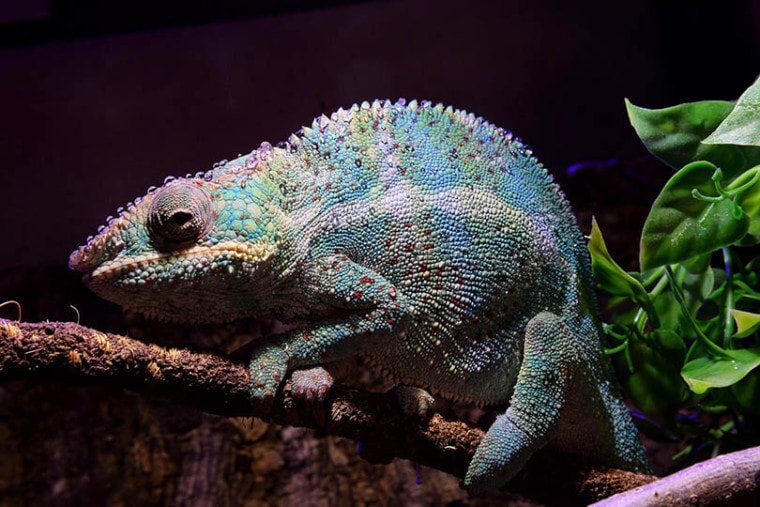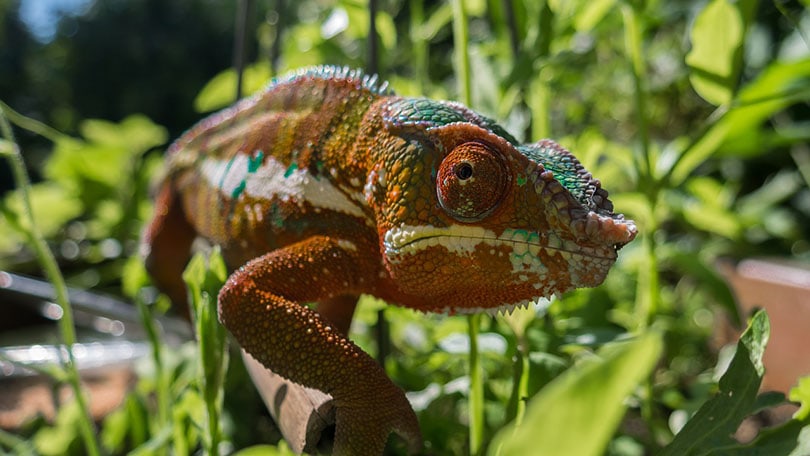
The world has many unusual species that we rarely see in the wild, and the chameleon is no exception. Over 200 species of chameleons exist, and they come in all shapes and sizes. The smallest species, Brookesia micra or leaf chameleon, can rest comfortably on the tip of your pinky, and it was only recently discovered during Madagascar expeditions from 2003 to 2007. The Parson’s chameleon is the largest type, and it can grow up to 27 inches.
For centuries, chameleons have amazed researchers and ordinary citizens with their multidirectional eyes and color-changing skills. Due to the reptile’s strange appearance and behavior, several myths about chameleons have unfortunately led some people to fear them and even kill them. Chameleons are not hazardous to humans or most animals, except for the species they depend on for sustenance.
 Brief Overview of a Chameleon’s Habitat
Brief Overview of a Chameleon’s Habitat
Over 85 species of chameleon live in Madagascar. They’re tropical reptiles who cannot tolerate frigid temperatures. Chameleons are also native to Spain, Asia, Portugal, and mainland Africa. Some species live on the ground, but most make their homes in shrubs and trees to hide from predators. In the wild, chameleons only live 2 to 3 years, but pet chameleons can live up to 12 years or more, depending on the species.

The 10 Chameleon Myths and Misconceptions
1. All Chameleons Can Display Vibrant Colors
Although all 202 species can change the color of their skin, some species have a limited range and only display dull hues. The namaqua and Brygoo’s chameleons can only change from brownish gray to green. In contrast, the panther chameleon can display red, blue, green, orange, and yellow. Some species with magnificent color changes include the verrucosus chameleon, minor chameleon, carpet chameleon, Labord’s chameleon, cape dwarf chameleon, and Knysna dwarf chameleon. Although they’re not as brilliant as the panthers, veiled chameleons are considered the best lizards for amateur reptile owners.

2. Chameleons Only Change Color to Hide
Biologists often mention how difficult chameleons are to spot in their environment, but the camouflage employed by the reptiles is not based solely on the surroundings. The temperature, humidity, mood, and mating status are the primary factors that persuade chameleons to change their colors. When mates try to impress females, they’ll display their brightest color combinations.
Chameleons, like most reptiles, cannot moderate their body temperatures without help from the sun. When they’re cold, they change to a darker tone that absorbs more heat, and when overheated, they’ll switch to a lighter shade to reflect the sunlight. As an owner of a pet chameleon can attest, an angry or stressed-out chameleon will turn a bright color to show its displeasure.
3. Chameleons Can Match Any Background of Colors
Online videos, produced with high-quality special effects, have convinced viewers that a chameleon can mimic a checkers board or other complicated color combination to hide in plain view. Although the reptiles can use limited colors to blend into the background, they’re incapable of imitating every color and pattern. Their color changes are triggered by hormone changes and nerve impulses.
When a female wants to reject a brightly colored suitor, she’ll turn a dull gray or brown to reject him. Engineers and scientists working in the field of bioinspiration study biological forces responsible for color change. Their studies have led to the development of a prototype T-shirt that uses a process similar to a chameleon’s to change color.

4. Chameleons Cannot Be Handled as Pets
Some would-be reptile owners may be hesitant to purchase a chameleon because they heard that the lizards have to be kept like fish with as little human contact as possible. Chameleons, like all reptiles, cannot form the same emotional bonds with humans like dogs and cats. However, they enjoy moving out of the confines of their enclosure and can learn to tolerate being handled by their owners. Chameleons are delicate, and quick movements spook them, but holding them is a vital skill to have when you need to take the reptile to the vet or retrieve it when it escapes.
Chameleon enthusiasts recommend being patient during hand training and leaving your hand in front of the lizard for several minutes until it crawls onto it. Chameleons do not enjoy being handled, and some reptile owners admit it can take several months before you can pick one up.
5. Chameleons Only Have Two Toes on Each Foot
Chameleons only appear to have two stubby toes on each foot from a distance. On closer inspection, you can see that three toes are grouped together, and the other two are joined as a pair. On the reptile’s front legs, the three-toed section is on the foot’s outer side, and on the hind legs, the three-toed section is on the inner side of the foot. Unlike other reptiles, chameleons have a ball and socket joint on their feet to rotate their feet easily while climbing trees and bushes.

6. A Chameleon Will Grow as Large as the Tank It Lives In
This myth has also been associated with other reptiles like bearded dragons and boa constrictors. Regardless of the tank’s size, a chameleon’s growth is determined by genetics, not living quarters. Thankfully, if you buy a 4-foot tank, your pet chameleon will not grow four feet long. If the myth were true, giant reptiles would cause a riot whenever they escaped. However, poor living conditions can disrupt a chameleon’s development and lead to an early death. Like snakes and other lizards, chameleons can die if they cannot access a heat source and their internal temperature drops too low.
7. Pet Chameleons Easily Die When Confined to a Tank
Some animals do not fare well in confinement, but chameleons live longer when they’re kept as pets. Compared to skinks, salamanders, and anoles, chameleons are slow-moving reptiles whose only defense against predators is their ability to hide. They’re not an easy pet to care for, but when you provide a clean enclosure, the ideal humidity level, healthy diet, and a heated rock or pad, most species can live 3 to 5 years. The Parsons chameleon can live over 12 years under ideal conditions.

8. Chameleons Release a Chemical That Makes Humans Impotent
This odd misconception seems humorous, but it’s caused some superstitious humans to kill the chameleons in India. Animal Rahat is an animal rights organization based in Maharashtra, India, that responds to animal emergencies much like PETA operates in the United States. In 2017, Animal Rahat rescued a chameleon on an almond tree when irate villagers tried to kill the lizard. Chameleons are not usually seen near the village, and the volunteers helping with the rescue speculated that the lizard may have hitched a ride on a vegetable truck. Chameleons can bite, but they do not carry venom or produce a sterility chemical.
9. Chameleons Reorganize Pigments in Their Skin to Change Color
While this myth is not entirely false, the color change in chameleons is more complex. Chameleons have several layers of skin called chromatophores, and the top layer is transparent. Brown melanin pigments called melanophores are contained within organelles in the deepest layer. The next layer has iridophore cells with blue pigments reflecting blue and white light, followed by the xanthophores and erythrophores layers containing yellow and red pigments. When the chameleon’s body temperature or mood changes, the nervous system directs the chromatophores to expand or contract. The expansion or contraction changes the color of the cells and allows colorful species like the Parson’s chameleon to display vibrant color combinations.

10. All Chameleons Lay Eggs
Although most species lay eggs, some lizards like the Jackson’s chameleon and dwarf chameleons from Kenya and Tanzania give live birth. A Jackson’s chameleon can birth up to 30 babies, but females are not known for their motherly instincts. Infant chameleons do not receive food or hunting instructions from their mothers. They immediately search the area for insects and learn to survive by instinct. Other species of chameleons dig deep holes in the ground to lay eggs.
 Conclusion
Conclusion
Chameleons may be slow-moving and have alien-like features, but they have powers that few creatures possess. Depending on the temperature, reptile’s mood, humidity, and mating status, chameleons can alter their appearance with brilliant displays of color. Scientists have not unlocked all the mysteries of the reptile’s abilities, but they have a better understanding of why and how chameleons’ strange behavior allows them to survive and evade predators. More research can help dispel the misconceptions surrounding the amazing reptiles and prevent superstitious humans from injuring or killing them.
Featured Image Credit: aixklusiv, Pixabay
 Brief Overview of a Chameleon’s Habitat
Brief Overview of a Chameleon’s Habitat





